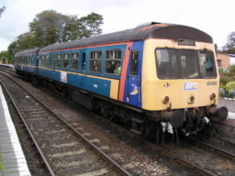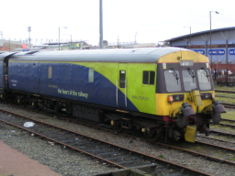British Rail Class 101

The British Rail Class 101 diesel multiple units were built by Metro-Cammell at Washwood Heath in Birmingham from 1956 to 1959, following construction of a series of prototype units. This class proved to be the most successful and longest-lived of all BR's First Generation DMUs, with the final five units being withdrawn on 24 December 2003. The oldest set was, by then, just over 47 years old.
Original TOPS classes
When TOPS was originally introduced only the Driving Motor Brake Second (DMBS) and the Driving Motor Composite (with Lavatory) (DMC(L)) were classified as class 101 or class 102. The Driving Trailer Composite (with Lavatory) (DTC(L)) were either Class 144 or Class 147. The Trailer Standards (with Lavatory) (TS(L)) were Class 162, the Trailer Brake Second (with Lavatory) (TBS(L)) were Class 168 and the Trailer Composite (with Lavatory) (TC(L)) were Class 171.
Later all the cars were reclassified, becoming class 101.
In fiction
In The Railway Series books by Rev.W.Awdry, the character Daisy the Diesel Rail-Car was introduced to assist on the Branch Line when Thomas was away for repair.
Daisy is undoubtedly based on the Metro-Cammell DMUs, but is a one-off, being a single railcar (akin to the Class 121 'bubble cars'). Although normally considered to be a Class 101, Daisy is always depicted with the distinctive valances around the buffer beams that distinguishes the lightweight prototype units.
Preservation
Several vehicles have been preserved on heritage railways.
| Vehicle numbers | Set number | Livery | Location | Comments | ||
|---|---|---|---|---|---|---|
| 50321 | - | 51427 | 960993 | BR Green | Great Central Railway | Previously sandite unit 977900+977899. |
| 51187 | - | 51512 | 101684/687 | Strathclyde Orange | Cambrian Railway Trust | - |
| 51188 | - | - | 101694 | BR Blue | Ecclesbourne Valley Railway | - |
| 51189 | - | 51803 | 101660/676 | Regional Railways | Keighley and Worth Valley Railway | - |
| 51205 | - | 56055 | 101676/662 | BR Green | Cambrian Railway Trust | - |
| 51210 | 59509 | 53746 | 101678 | Regional Railways | Wensleydale Railway | One of final 5 units in service. 59509 is a Class 117 vehicle. |
| 51213 | - | 56358 | 101659/653 | BR Blue | East Anglian Railway Museum | - |
| 51226 | - | 51499 | 101695 | Strathclyde Orange | Mid-Norfolk Railway | - |
| 51228 | - | 56062 | 101681 | BR Blue | North Norfolk Railway | - |
| 51247 | 59500 | - | 101687 | Strathclyde Orange | Wensleydale Railway | 59500 is a Class 117 vehicle. |
| 51434 | 59117 | 51503 | L836 | BR Blue/Grey | Mid-Norfolk Railway | - |
| 51505 | - | 54365 | 101682/661 | Regional Railways | East Anglian Railway Museum | - |
| 51511 | 59539 | 50204 | 101680 | BR Green | North Yorkshire Moors Railway | One of final 5 units in service. |
| 53160 | - | 53164 | 101685 | BR Green | Elsecar Railway | One of final 5 units in service. |
| 53170 | 59303 | 53253 | 101692 | Caledonian Blue | Midland Railway Butterley | Painted in special Caledonian Blue livery. |
| 53193 | - | 53203 | 960992 | BR Blue/Grey | Great Central Railway | Previously sandite unit 977898+977897. |
| 53256 | - | 54343 | 101660 | Regional Railways | East Kent Railway | - |
| 53266 | - | - | 101693 | Strathclyde Orange | Great Central Railway | - |
| 54342 | - | - | - | BR Blue/Grey | Private site, Royston | Previously internal user no. 042222. |
| 54347 | - | - | 101663 | Regional Railways | Bressingham Steam Museum | - |
| 54356 | - | - | - | LNER Green/Cream | Gloucestershire Warwickshire Railway | Rebuilt to observation saloon 6300. |
| 54408 | - | - | 101654 | Regional Railways | Spa Valley Railway | - |
| 51192 | - | 54352 | 101693/657 | BR Green | East Lancashire Railway | Unit on long term loan from the National Railway Museum. |
References
- The Railcar Association
- Motive Power Recognition: 3 DMUs. Colin J. Marsden
- British Railway Pictorial: First Generation DMUs. Kevin Robertson
- British Rail Fleet Survey 8: Diesel Multiple Units- The First Generation. Brian Haresnape
- A Pictorial Record of British Railways Diesel Multiple Units. Brian Golding
British Rail diesel multiple units | |
|---|---|
| First generation units: | |
| First Generation Original TOPS: | |
| First generation units (pre-TOPS): | |
| Second generation units: | |
| Diesel-electric units: | |
| Southern Railway designations: | |
| Families | |

